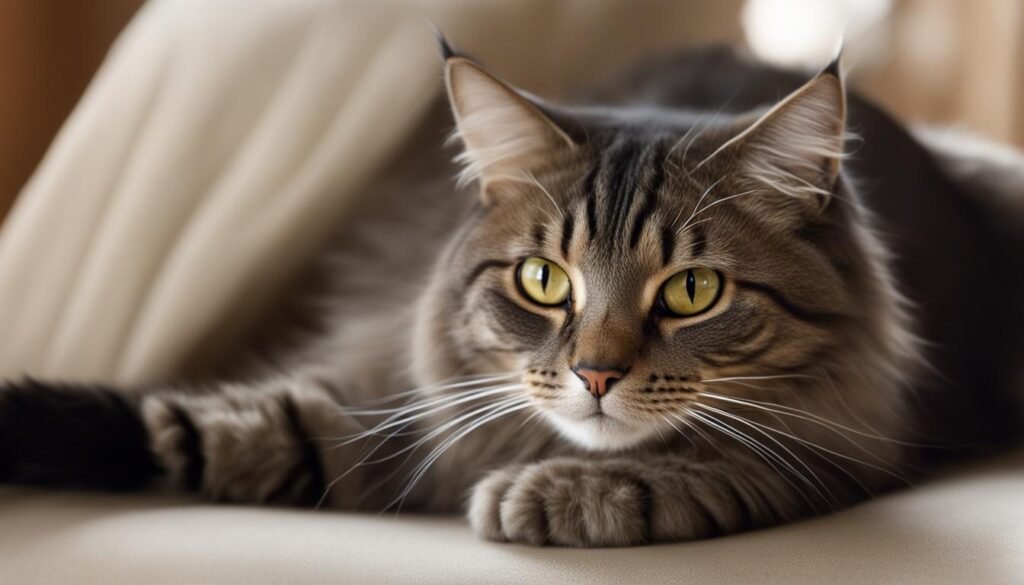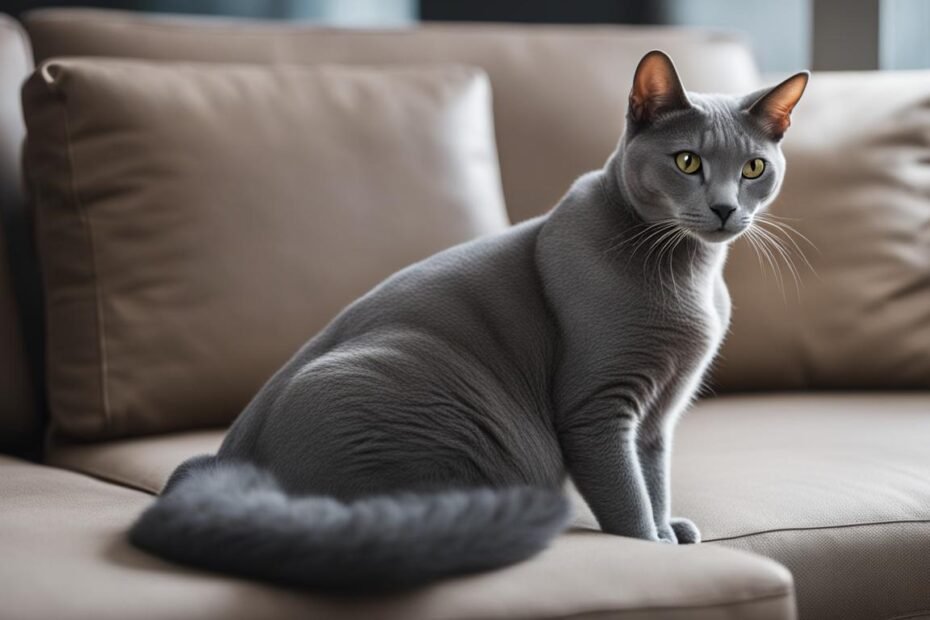If you love cats but suffer from allergies, there’s good news for you! Certain cat breeds produce lower levels of allergens, making them a great choice for individuals who experience allergies. While no cat is entirely hypoallergenic, these hypoallergenic cat breeds can provide a healthier living environment for those with sensitivities. Let’s explore the top hypoallergenic cat breeds and discover how you can adopt a hypoallergenic cat.
Key Takeaways:
- Hypoallergenic cat breeds are suitable for individuals with allergies
- These breeds produce lower levels of allergens
- No cat breed is 100% hypoallergenic
- Thorough research and spending time with the breed are essential before adoption
- Consultation with an allergy specialist can help manage allergies
What Is a Hypoallergenic Cat?
While all cats produce allergens, some breeds, commonly known as “hypoallergenic cats,” produce lower levels of the proteins that trigger allergies. It’s important to note that there is no cat breed that is completely hypoallergenic, but certain breeds may be more suitable for individuals with allergies. The proteins that cause allergies can be found in a cat’s fur, saliva, urine, and dander.
These allergens can trigger reactions in susceptible individuals, leading to symptoms such as sneezing, itching, watery eyes, or difficulty breathing. The main allergenic proteins in cats are Fel d 1 and Fel d 4, which are produced mainly in the salivary and sebaceous glands. When a cat grooms itself, it spreads these proteins onto its fur, which can then be dispersed into the environment as dander.
Despite their lower allergenicity, hypoallergenic cats still produce allergens, and individuals with severe allergies may still experience symptoms. However, hypoallergenic breeds often produce fewer allergens or have a different protein composition, making them a better choice for people with milder allergies. It is still important for individuals considering adopting a hypoallergenic cat to spend time with the breed and consult with an allergy specialist to determine their suitability.
| Breed | Allergen Levels |
|---|---|
| Siberian | Low |
| Siamese | Low to Moderate |
| Bengal | Low |
| Russian Blue | Low |
| Sphynx | Low to Moderate |
| Devon Rex | Low to Moderate |
| Cornish Rex | Low |
| Javanese | Low |
| Balinese | Low |
| Oriental Shorthair | Low |
| Burmese | Low to Moderate |

Adopting a hypoallergenic cat can be a great option for individuals with allergies who still want to experience the joy of owning a feline companion. By choosing a breed with lower allergen levels, individuals may be able to minimize their exposure to cat allergens and reduce their allergy symptoms. However, it is important to remember that individual sensitivities can vary, and some individuals may still experience allergies even with hypoallergenic breeds.
Consulting with an allergy specialist and spending time with the breed before adoption can help individuals determine if a hypoallergenic cat is the right choice for them. It’s also essential to create an allergen-free home environment by regularly grooming the cat, keeping the house clean, and using air purifiers. By taking these steps, individuals with allergies can enjoy the companionship of a hypoallergenic cat while minimizing their allergic reactions.
Hypoallergenic Cat Breeds: 11 Cats That Are ‘Hypoallergenic’
If you suffer from allergies but still dream of having a cat, you’ll be pleased to know that there are several hypoallergenic cat breeds that produce lower levels of allergens. While no cat is completely hypoallergenic, these breeds can be a great option for individuals with sensitivities. Let’s explore 11 cat breeds that are known for being allergy-friendly and low-allergen.
Siberian
The Siberian cat breed is not only beautiful but is also known for producing lower levels of the Fel d 1 protein, which is the primary allergen responsible for cat allergies. Their long, dense fur may seem like it would trigger allergies, but their saliva contains fewer allergenic proteins, making them a suitable option for allergy sufferers.
Siamese
The Siamese cat breed is another hypoallergenic option. They have short fur and are known to produce fewer allergens compared to other cat breeds. Their low-allergen coat combined with their playful and affectionate nature makes them a popular choice for those with allergies.
Bengal
The Bengal cat breed is not only known for its striking appearance but also for its low-allergen coat. Bengals have a pelt-like coat that requires minimal grooming, which can help reduce the spread of allergens. Additionally, they have a reputation for producing fewer allergenic proteins, making them a good choice for allergy sufferers.
| Low-Allergen Cat Breeds | Description |
|---|---|
| Siberian | Produces lower levels of the Fel d 1 protein, suitable for allergy sufferers. |
| Siamese | Short fur and lower allergen production compared to other breeds. |
| Bengal | Pelt-like coat and fewer allergenic proteins. |
| Russian Blue | Produces lower levels of the Fel d 1 protein, making them hypoallergenic. |
| Sphynx | Hairless breed that produces significantly fewer allergens. |
| Devon Rex | Curly-haired breed with reduced allergenic proteins. |
| Cornish Rex | Similar to Devon Rex, produces lower levels of allergens. |
| Javanese | Long-haired breed with reduced allergenic proteins. |
| Balinese | Long-haired breed with minimal shedding and fewer allergens. |
| Oriental Shorthair | Short-haired breed with lower allergen levels. |
| Burmese | Produces lower levels of allergens and has a silky coat. |
These are just a few examples of hypoallergenic cat breeds that can bring joy to allergy sufferers. Remember, it’s important to spend time with the breed you’re interested in and consult with an allergy specialist to ensure compatibility. With proper care and management, you can enjoy the companionship of an allergy-friendly cat.
Tips for Adopting a Hypoallergenic Cat
Adopting a hypoallergenic cat can be a great option for individuals with allergies who still want to enjoy the companionship of a feline friend. However, it’s important to keep a few key tips in mind to ensure a successful adoption and manage your allergies effectively.
Thorough Research and Allergy Testing
Before bringing home a hypoallergenic cat, it’s crucial to do thorough research on the breed you’re interested in. Understand the specific characteristics, grooming needs, and potential allergen levels associated with that breed. Additionally, consider consulting with an allergy specialist to determine your specific allergies and level of sensitivity to cat allergens. Allergy testing can help you identify potential triggers and make an informed decision.
Spending Time with the Cat
Prior to adoption, spend some time with the cat you’re considering. Visit the breeder or shelter and interact with the cat to assess your individual reaction. While no cat can guarantee a complete absence of allergies, spending time with the cat can give you a better idea of how your allergies might be affected. If possible, consider fostering a cat before making a permanent commitment to ensure compatibility.
Consulting with an Allergy Specialist
An allergy specialist can provide valuable guidance on managing your allergies effectively when living with a cat. They may recommend medications, allergen immunotherapy, or other techniques to alleviate your symptoms. It’s important to follow their advice and stay consistent with any prescribed treatments to minimize the impact of cat allergens on your health.
| Tips | Explanation |
|---|---|
| Keep Your Home Clean | Regularly cleaning your home can help reduce the presence of allergens. Vacuum carpets and upholstery, dust surfaces, and wash bedding frequently to minimize allergen buildup. |
| Invest in an Air Purifier | An air purifier with a HEPA filter can help capture and remove allergens from the air, creating a cleaner and more allergen-free environment. |
| Choose Hypoallergenic Cat Food | Some cat foods are specifically formulated to reduce allergens in a cat’s hair and dandruff. Consider opting for these hypoallergenic cat food options to further minimize exposure to allergens. |
By following these tips, you can increase your chances of successfully adopting a hypoallergenic cat and managing your allergies effectively. Remember, every individual’s allergies are unique, so it’s important to find the right balance that works for you and your furry companion.

What Causes Allergies to Cats?
Contrary to popular belief, cat allergies are not caused by fur but by certain proteins in a cat’s body. These proteins, known as Fel d 1 and Fel d 4, can be found in a cat’s skin, saliva, urine, sweat, and dander. Dander, which consists of dried, dead skin cells that cats shed, is a common trigger for allergies. Some individuals may have reactions even with minimal exposure to these allergens.
One of the main culprits behind cat allergies is the Fel d 1 protein, which is primarily produced in a cat’s salivary glands. When cats groom themselves, the protein is transferred to their fur. As a result, being in close proximity to a cat, especially one that frequently grooms itself, can lead to allergic reactions. The Fel d 1 protein is incredibly small and lightweight, allowing it to float in the air and settle on various surfaces, making it difficult to avoid.
Cat allergens, including the Fel d 1 protein, can trigger a wide range of allergic reactions in sensitive individuals. Common symptoms include sneezing, coughing, itchy and watery eyes, stuffy or runny nose, and even skin rashes. In severe cases, cat allergies may also cause difficulty breathing and asthma attacks. It’s essential for individuals with cat allergies to take preventative measures and minimize their exposure to allergens.
| Allergen | Source |
|---|---|
| Fel d 1 protein | Cat’s skin, saliva, and urine |
| Fel d 4 protein | Cat’s skin and saliva |
| Der p 1 protein | Dust mites |
| Pet dander | Dead skin cells and hair |
Quote: “One of the main culprits behind cat allergies is the Fel d 1 protein, which is primarily produced in a cat’s salivary glands.” – Allergy Specialist
Top 10 Hypoallergenic Cat Breeds
If you’re looking for an allergy-friendly cat breed, consider these top 10 hypoallergenic cat breeds. While no cat breed can be considered 100% hypoallergenic, these breeds have been found to produce lower levels of allergens, making them a popular choice for individuals with allergies. Whether you’re a cat lover with allergies or simply want a feline companion without the worry of constant sneezing and itching, these breeds may be more tolerable for you.
| Breed | Description |
|---|---|
| Snowshoe | A medium-sized breed known for its affectionate and social nature. Its short coat produces less dander and allergens. |
| Devon Rex | A unique-looking breed with curly hair that sheds less than other cats, reducing the spread of allergens. |
| Cornish Rex | Similar to the Devon Rex, the Cornish Rex has a curly coat that minimizes the release of allergens. |
| Siamese | Known for its striking blue eyes and short coat, the Siamese breed produces fewer allergens compared to other cats. |
| Bengal | A breed with a distinctive spotted coat and low levels of allergens, making it a popular choice for allergy sufferers. |
| Russian Blue | Characterized by its beautiful blue coat, the Russian Blue breed produces less of the allergen protein Fel d 1. |
| Oriental Shorthair | A sleek and graceful breed that comes in various coat colors. It is known for its low-allergen qualities. |
| Sphynx | Perhaps the most well-known hypoallergenic breed, the Sphynx is hairless, minimizing the spread of allergens. |
| Balinese | A long-haired breed that produces fewer allergens due to its unique coat composition. |
| Siberian | A large and robust breed that has been found to produce lower levels of the allergen protein Fel d 1. |
These hypoallergenic cat breeds offer a range of personalities, appearances, and sizes, allowing you to find the perfect companion that fits your lifestyle. Remember to spend time with the breed before bringing them home to ensure your allergies do not react negatively. Consult with an allergy specialist for additional guidance in managing your allergies if necessary.
“Choosing a hypoallergenic cat breed can make a significant difference for individuals with allergies. These breeds have been specifically selected for their lower allergen production, giving allergy sufferers the opportunity to enjoy the companionship of a cat without compromising their health.” – Allergy Specialist
Keep in mind that while hypoallergenic cat breeds can help reduce allergens, regular grooming, cleaning, and maintaining a clean living environment are crucial for managing allergies effectively. Additionally, innovative cat food options are available that can significantly reduce allergens in a cat’s hair and dandruff.
Conclusion
In conclusion, while no cat breed can be considered completely hypoallergenic, there are certain hypoallergenic cat breeds that produce lower levels of allergens, making them suitable for individuals with allergies. These allergy-friendly cats can provide companionship without triggering severe allergic reactions.
When considering adopting a hypoallergenic cat, it is crucial to conduct thorough research on the breed and spend time with the cat before bringing them home. This will help ensure that your allergies do not react negatively to the specific breed. Consulting with an allergy specialist can also provide valuable insights and guidance in managing allergies when living with a cat.
By following these tips and adopting a hypoallergenic cat, individuals with allergies can enjoy the benefits of feline companionship without compromising their health. These hypoallergenic cat breeds, such as Snowshoe, Devon Rex, Cornish Rex, Siamese, Bengal, Russian Blue, Oriental Shorthair, Sphynx, Balinese, and Siberian, have been found to produce lower levels of allergens. While no cat breed is 100% hypoallergenic, these breeds may be more tolerable for people with allergies.
FAQ
Are hypoallergenic cats completely free of allergens?
No, hypoallergenic cats still produce allergens, but they produce lower levels of the proteins that trigger allergies, making them more suitable for individuals with allergies.
What breeds are considered hypoallergenic?
Some hypoallergenic cat breeds include Siberian, Siamese, Bengal, Russian Blue, Sphynx, Devon Rex, Cornish Rex, Javanese, Balinese, Oriental Shorthair, and Burmese.
How can I adopt a hypoallergenic cat?
When adopting a hypoallergenic cat, it’s important to research the breed, spend time with the cat before bringing them home, and consult with an allergy specialist. Keeping your home clean and considering innovative cat food options can also help manage allergies.
What causes allergies to cats?
Cat allergies are caused by certain proteins, specifically Fel d 1 and Fel d 4, which can be found in a cat’s skin, saliva, urine, sweat, and dander. Dander, the dried, dead skin cells that cats shed, is a common trigger for allergies.
What are the top hypoallergenic cat breeds?
The top 10 hypoallergenic cat breeds include Snowshoe, Devon Rex, Cornish Rex, Siamese, Bengal, Russian Blue, Oriental Shorthair, Sphynx, Balinese, and Siberian. These breeds have been found to produce lower levels of allergens.
